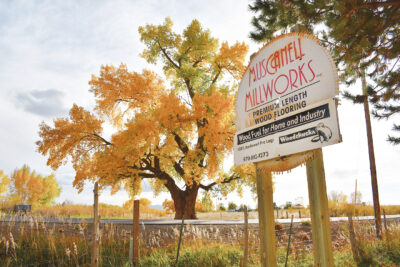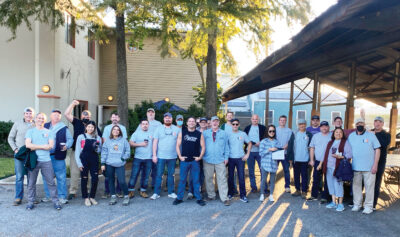No, that’s not a typo in the title! Let me explain…
You’re already familiar with our signature Truth About Trees learning kit that teaches K-3 students about sustainable wood products, and industry careers.
NAFF is preparing to develop a digital version of the kit designed specifically for the junior high age group. Recently, I had the opportunity to sit down with potential sponsors and answer their questions about the importance, relevance, and impact of this first-of-its-kind learning resource.
Q: What was the motivation behind creating this junior high app?
A: We wanted to build on the early elementary education that’s provided by the Truth About Trees kits. The idea being that the app would cycle back and revisit topics introduced years before, but with additional age-appropriate lessons and activities.
The Truth About Trees kit lays the groundwork, and the junior high app will reinforce the value of sustainable forestry, the benefits of choosing wood products, and expose students to the many career opportunities that exist in this industry with or without a 4-year degree.
Q: What made you decide to reach out to this particular age group?
A: Two main points guided our decision. One is that this age group, grades 6, 7, and 8, doesn’t have as much specialized programming available to them. Most forestry educational efforts focus either on early elementary or on high school. Two, this is a critical age–during this period, kids are beginning to think about their future–working, careers, higher education. We want to open their eyes to the opportunities that exist within the forest and wood products industry.
Q: Are junior high kids ready to learn about careers?
A: Absolutely! College is not always the best answer for all kids to the question, “what are you doing after high school.” Economics, personal interests, and a variety of other factors come into play.
Many kids who are at risk or are in low-income situations especially need to be aware that they have options open to them that can lead to fruitful careers and well-paying jobs to sustain themselves and build a solid future.
Young people need to know that jobs in fast food aren’t the only ones available without a college degree. Specifically, the wood products industry offers numerous job opportunities for kids right out of high school–an easy point of entry into the business. Alternatively, young people can enter the field through technical school training or through alternative school options, like the UFP Business School, which provides the equivalent of a bachelor’s degree in two years with zero debt afterwards.
Q: What kinds of jobs are available?
A: We want to dispel the myth that working in the forestry or wood products industry means you’re either a lumberjack or a park ranger.
A whole world of job opportunities exist, in mills, lumber, paper manufacturing, kiln drying, transportation, and more. Engineering, IT, accounting, and many other types of professional training can also lead to careers in this industry.
Q: Where are these jobs located–do young people have to leave home and move to another state or region to enter the field?
A: Every state has industry opportunities–from lumber yards, to forestry, or beyond. Companies in every state sell, make, harvest, plant – many, many opportunities without moving to a remote location.
Q: How does the Truth About Trees App work? What kinds of activities and learning outcomes are involved?
A: The app is gamified, so it’s designed to work on an ipad or laptop in the classroom with another portion that is intended to work at home, on a phone. Activities may include a scavenger hunt, tree identification, and a harvesting game.
We want to meet kids where they are–in the digital space–and help them make the connection to the physical world of working with trees. Kids can use the app to gather information and resources about educational opportunities–tech school programs, UFP Business School, NHLA Inspector Training School, and other programs. The tool will bridge the gap to meet them where they are to provide useful resources and information and fulfill science, environmental, and even language and literacy curriculum.
Q: Who will use the app–where will kids encounter it?
A: The app is designed to be part of the science curriculum. Our vision is that it would be available for every school and teachers can decide how to integrate the teaching. We also want to be sure to get it into the hands of school counselors and other educators who work with kids as they begin to explore career opportunities, especially for kids who want or need to begin working without first attending college.
Q: Why is it important for leaders in the wood products industry to know about this program?
A: Many people who are wood industry leaders today entered the field almost by accident. They did not plan on finding a career here, yet they look back and see that they have been very fortunate to have entered the industry. They’re immensely satisfied, doing rewarding work, and they’re excited about what they do.
While it’s great that so many leaders found their way here serendipitously, if we want the industry to thrive and grow, we can’t wait for talented young people to stumble into careers in the field.
We need to lay a foundation to help young people learn about and appreciate the potential and let them see how rewarding a career in the wood products industry can be. Built on this understanding, NAFF hopes to help develop a sustainable flow of talent entering the industry.
Q: How can companies or individuals help get this app into the hands of junior high kids?
A: Here are three ways you or your company can get involved:
- Become a sponsor for the app. We’re aiming for a 2024 release and have a few spots open to add corporate sponsors; if you’re interested in helping make this happen, just get in touch with me directly at adeford@northamericanforestfoundation.org.
- Bring kids out for field trips. Let them see for themselves what you do and what kinds of jobs are possible in the forest products industry. Help make it real for them.
- Make a donation. You or your company can help cover the costs of development or partner with us for a special campaign–and donations of any size are always welcome. Reach out to me directly or make a tax-deductible donation on our website.
Bottom line, share what you know.
Talk to young people around you–let them in on the truth about work in the forest products industry. Help them understand it’s a field in which a person can make a good living, work with dedicated people, and feel good about his or her role in protecting the health of the planet.
They’ll be APP-y you did!








